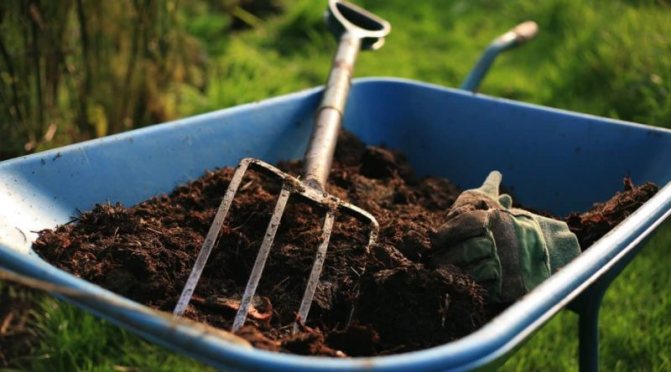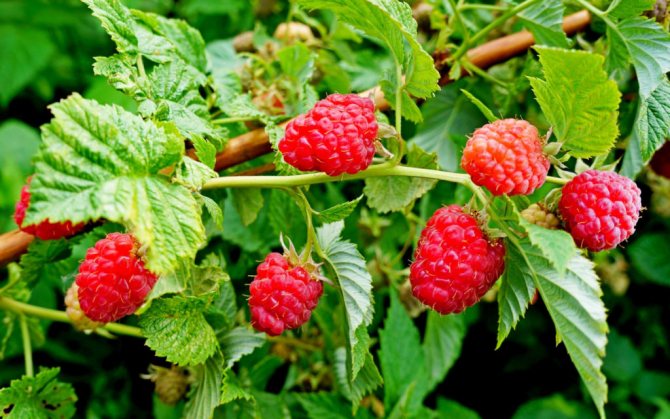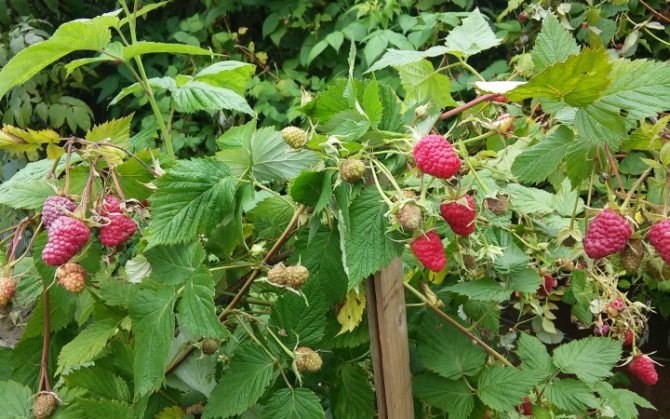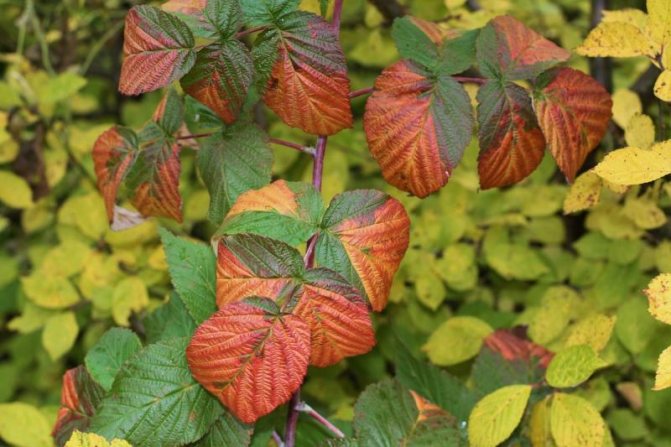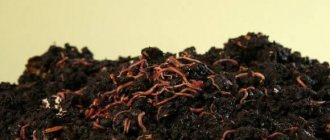When to fertilize your raspberry plantation
For ordinary varieties, care begins in late July and early August. First, pruning is carried out, then abundant watering and fertilization for raspberries - in the fall, all that remains is to mulch the soil in order to reduce moisture evaporation.

How to feed remontant raspberries in September, will tell you the appearance of the plant:
- the edges of the leaves dried up, and the berries of the second harvest were sour - potassium deficiency;
- thin shoots and small leaves - it's time to add phosphates.
Top dressing of raspberries in the fall is carried out with those fertilizers that most fully correspond to the state of the soil. If organic matter was introduced a long time ago, 2 - 3 years ago, then it is time to restore the fertile layer. For raspberries, this is important, since their root system is in the upper soil layer, and it must be enriched with minerals and organics.
How to feed raspberries in the fall after pruning, using organic substances:
- Wood ash. The content of potassium and phosphorus in this substance is maximum. Ash is used dry or insisted on water. Then it is evenly distributed in the raspberries and sprinkled with soil. Plant residues serve as food for beneficial soil bacteria, which create a fertile layer. Quantity per square meter - 300 g per bucket of water, leave for 3-4 days. Make a depression around the bush and pour the solution there, cover it with earth.


- Bone flour. Contains phosphorus, calcium and trace elements. A feeding for raspberries is introduced in the fall in a dry form, after which 2 - 3 years you can not fertilize the soil with phosphates. Bone waste dissolves for a long time and constantly release nutrients into the soil.
- Siderata for raspberries in autumn - an alternative to manure, but much cheaper. You can sow lupine, clover, vetch, cereals between the bushes, and in winter, cut and mulch the soil with greens. To accelerate decomposition, the green manure layer is covered with straw and watered. When to plant green manures for raspberries depends on the climate: for their growth, there should be a margin of time of 1.5 - 2 months.
- The manure is used semi-rotted or rotted so that the nitrogen content meets the autumn standards. Fresh substance is not used due to the large amount of ammonia, which stimulates the growth of the shoots. In the fall, this is not necessary, since the new branches will not have time to woody and will die in the frost. This is a dangerous bacterial or fungal infection of the entire plantation.
Organic matter - these are the substances with which you can feed raspberries in August, because before the onset of cold weather another 2 - 3 months and organic matter will have time to partially decompose and support the root system.
Why do you need autumn feeding
They feed raspberries in spring and summer, but autumn events are indispensable if you want to get a full harvest next year.
The root system of the plant is close enough to the surface, therefore, it needs to create the most favorable conditions before the onset of cold weather.
Novice gardeners should be aware of a number of behavioral features of the culture that are a signal for immediate action:
- The leaf blades acquire a brown tint along the edges, visually resembling a burn - a sign of a lack of potassium. The danger lies in reducing the already average frost resistance in terms of indicators.
- Massive yellowing of foliage and a simultaneous change in its size to smaller ones indicate a nitrogen deficiency. An excessive amount of this compound can be judged by the brown color of the crown and the increased growth of the processes. In the latter case, the yield decreases markedly, the berries crumble.
- The first signs of phosphorus starvation include thin and weak shoots that break easily under any mechanical stress.
- Magnesium deficiency is indicated by slow leaf development, as well as a rapid color change to yellow, which spreads from the center to the edges.
- Yellowing of leaf blades with persistent green veins is considered a symptom of iron deficiency.
Minerals for raspberry
Autumn feeding of raspberries in winter can be carried out with mineral mixtures - one-component or two-component. Essential substances are phosphates and potassium, so that the plants overwinter well.
How to fertilize raspberries in the fall, using purchased mixtures:
- superphosphate - 40 g per square meter dry but it is better to prepare a solution by pouring boiling water over the granules and waiting for complete dissolution;
- potassium sulfate - 30 g per square meter;
- potassium magnesium - a natural mineral that, in addition to potassium, contains magnesium and sulfur.
Feeding raspberries in August can be done with potassium chloride. Not all plants love it, since it inhibits their growth, but in the fall, potassium chloride can be added, since the chlorine will have time to erode and will not harm the plants.
Combined mixtures, than to fertilize raspberries in the fall, must be selected in the correct proportions. The percentage of nitrogen should be less, potassium and phosphorus - more, because they are responsible for the wintering of the raspberry tree.
It is not recommended to use only mineral fertilizers for more than 4 years, since without organic additives the soil is depleted, the upper layer quickly gives off moisture and cracks, which negatively affects the general condition of plants with a superficial root system.


Therefore, the best option for feeding raspberries in August-September is combined fertilizers - organic and mineral.
Folk methods
In order to fertilize the plant, not only industrial preparations are used, but also natural, herbal ingredients. Recommended nutritional compositions:
- IN banana peel contains a lot of potassium, which makes it incredibly healthy for raspberries. Within a week, 10 fruit skins are infused in 10 liters of water. The resulting solution is poured over the ground under the bushes, which will help saturate the roots with useful substances.


- Baker's yeast will contribute to the rapid dissolution of the applied organic fertilizers and will enhance the nutrition of the bushes. So, 10 g of dry yeast and 100 g of sugar must be dissolved in 10 liters of warm water. Let it brew for 3 hours and mix with water in a 1: 5 ratio. Each bush is watered with this mixture. If you use compressed yeast, then 500 g of product should be used for 10 liters of water.


- Onion peel will help to saturate the raspberry with potassium and protect it from pests. Within two weeks, 50 g of husks are infused in 10 liters of water. The resulting solution is watered with raspberry plantings.


- Nettle and comfrey are used to strengthen the immunity of the plant, accelerate growth and saturation with potassium, magnesium and calcium. Within two weeks, it is necessary to insist in 10 liters of water, 0.5 kg of each type of grass. Then the solution must be filtered and diluted with water in a ratio of 1:10. Fertilizer is watered around the soil around each bush.


- Infusion of 2 liters of chicken manure, 3 kg of manure, 1 kg of nettle and 0.25 kg of ash... The components are soaked in 20 liters of water and infused in a warm place for one week. Then the mixture is diluted with water in a ratio of 1:10. Top dressing is carried out at the rate of 0.5 liters per 1 bush.


Fertilizing raspberries when transplanting in the fall
The shrub is transplanted in early August so that young plants have time to take root in a new place.


Fertilizers when planting raspberries in the fall are applied to the hole. It can be rotted manure, composted, based on peat or with the addition of river silt, mineral mixtures.
After planting, no fertilizers are applied on chernozems for 2 - 3 years. If the soil in the region or on the site is sandy, then you will have to make top dressing regularly, since the nutrients do not stay in the sand, but are washed out into the lower layers, from where the short raspberry roots cannot get food. On sandy soils, the total amount of dressings is divided by three and applied in small portions.
Forming and sanitary pruning
Preparation of raspberry bushes for wintering begins with cleaning the area and pruning branches. This should be done after the late harvest, after the leaves begin to fall off on their own.
Algorithm of work:
- Cut off all leaves, young unripe shoots. At negative temperatures, they will die and become a source of rot for healthy branches.
- All damaged parts of the plant are necessarily cut off and removed from the site. They must be burned immediately to prevent contamination of other crops.
- Old branches are pruned to a height of 20-25 centimeters from ground level. Then they will need to be bent to the ground and secured.
- Thin out all the young growth that has grown between the bushes. For comfortable growth, there should be at least 50-60 centimeters of free space between the plants.
- Dry earth or peat must be sprinkled on the root area. You can cover the branches with a thick cloth or agrofiber. Do not use polyethylene and other airtight materials to prevent rotting of the shoots. Straw or spruce forest is often used as a shelter; in winter, you can additionally rake snowdrifts onto the shoots.
It should be noted that the fall pruning procedure is extremely important for the care of raspberries. This will prevent thickening of the shoots, increase productivity, and also allow you to take care of the plantings without any problems.
You may be interested in: Peach, fertilizer in the fall


For beginner gardeners about raspberries
For novice gardeners, feeding raspberries in the fall may seem like a completely unnecessary action that takes time and effort. On rich soils, yes. The first two harvests will be excellent, especially if the plants are varietal. The further you go, the less sweet the berries will be and the more you will have to tinker with diseases and pests.
Video: What and when to feed raspberries
The growth process can be compared with the activity of the human body, which requires the main components of nutrition - proteins, fats and carbohydrates. In plants, these are nitrogen, potassium and phosphorus. At the same time, it is difficult for a person to maintain immunity without vitamins. In plants, the role of vitamins is played by trace elements that are necessary in small quantities, but the benefits of them are tangible.
Before exertion, a person is given high-calorie food so that the body can withstand. Plants also need nutrition, since they are stressed by the cold season.


